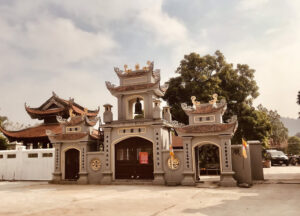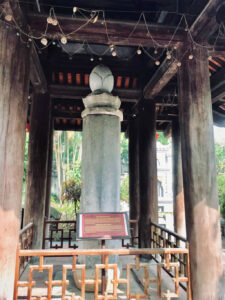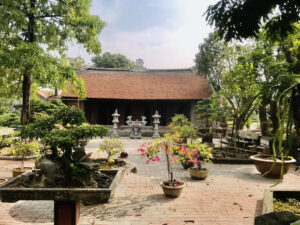Emperor Lê Hoàn, the third Emperor of the incipient nation of Dai Co Viet, ordered the construction of Chùa Nhất Trụ (“One Pillar Pagoda”) in the 10th century. This edifice was designed specifically to house a large “sutra pillar” (Lăng Nghiêm) engraved with the sutras (wise words) of the Buddha’s teachings.
These multi-faceted carved pillars have had a major religious reputation in the region as magical objects. Many were also constructed in China during the Tang (618-907) and Southern Song (1127–1279) Dynasties, a period where Chinese influence on Vietnam was still strong.
Such were their importance that in 1010, when Emperor Lý Thái Tông of the Ly Dynasty moved the capital to Thanh Long (Hanoi), he ordered the construction of a replica of sutra to be built near the current day Ba Đình district.
Sutra Pillar
The stone Buddhist sutra pillar at Nhất Trụ Pagoda is a designated national treasure and the Pagoda itself proposed as an addition to the UNESCO World’s cultural heritage list. Regardless of certification, it is a unique and beautiful part of Hoa Lu Ancient City and many pilgrims come to Hoa Lu specifically to visit this Pagoda and its revered artifact.
Some 4m high and weighing an estimated 4.5 tons, the Sutra Pillar is actually a composite of eight separate pieces of stone. All are intricately fitted together without mortar or adhesives and topped with an unopened lotus bud.
The eight faces of the pillar are engraved with an estimated 2500 words copied from the Buddhist scriptures, including the Shurangama Sutra, As the Dai Co Viet had yet to document their own language, the characters of the sutras are carved with Song Dynasty (Chinese) and Sanskrit (Indian) characters.
Over the course of the millennia and the depredations of numerous wars and countless pilgrims, there has been substantial weathering and many characters have worn away. But in the protected areas, the ancient words and the engraved lotus flowers are still sharp and clear, demonstrating the skill and reverence of the ancient master craftsmen. It also has become a symbol of the resilience of the Vietnamese nation and its spirituality.
Resilience and Resistance
That the pagoda has survived over ten centuries, through fire, flood, feast and famine is remarkable. Still standing today, it reminding visitors of how time negates all failures and successes, regret and jubilation. Many great and important events have faded from memory yet these silent ancient buildings remain quietly intact. To emphasis the point, the main Pagoda also houses a small museum of 10-11th century artifacts discovered during excavations at nearby Yen Thanh ancient village in Truong Yen commune.
Architecturally the pagoda is built in the early Vietnamese “Đinh” style (basically a “丁”shape facing the west). Along with the Sutra pillar, the pagoda consists of a main hall, the ancestral house, a living room, a dining room, and the traditional gate towers. The curved roof of the pagoda is designed in the classic “boat” style and features dragon motifs decorated tiles.
During the French Resistance Period, Chùa Nhất Trụ became an important meeting place for revolutionary officers and soldiers, a place to plan their movement but also to store weapons and important strategic documents. Again during the American resistance, the pagoda again served as a strategic meeting place and a stronghold for revolutionary supplies.
Interior Design
The Pagoda interior is incised with the reliefs of dragons and/or swords, the primary motifs of the ancient Le Dynasty who commissioned the building. The main hall contains four rows of Red Buddha statues adorned in gold trim, surrounded by paintings of stylized flowers, leaves, twisted vines, lotus flowers, seals, and lions.
Each year on the 15th day of the first Lunar month, there is a festival here to pray for the peace of the nation. On 8th day of the fourth Lunar month, the pagoda celebrates the Lap Ha (Lixia) ceremony, which signifies the beginning of summer. On 15th of the same month, Buddha’s birthday is celebrated.
Location
Nhất Trụ Pagoda is located in Yen Thanh village, Truong Yen commune, Hoa Lu district, Ninh Binh province. Around 8km from Ninh Binh city center, it is about 5 km from the Trang An boat station and a little less than 11 kilometres from Tam Coc village. It is also within easy walking distance of the Phat Kim and Dinh-Le temples, which makes it an excellent excursion during a visit to the Hoa Lu Ancient City. A “must” for anyone interested in Vietnamese spiritual history.
Nhat Tru Pagoda is one of the impressive pagodas in Ancient Hoa Lu City and, with its ancient Sutra and small museum of recovered artifacts, one of the more interesting. Just remember it is still a very living and respected place of worship so dress and act appropriately.
Entry is free but donations for the upkeep of both the Pagoda and its attendants are welcome.




